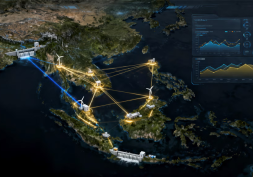Darkness is no enemy to this solar tech
Follow CDE
PDF Download

NUS CDE researchers demonstrate the possibility of harnessing solar power even under after the sun has set.
Harnessing the sun’s energy continuously — even without direct sunlight — has long been an alluring goal. The growing demand for reliable power sources in off-grid applications, particularly for the increasingly prevalent Internet-of-Things sensors, has fuelled extensive research in this area. Innovations in off-grid renewable energy systems are crucial for delivering secure, affordable electricity to rural communities all over the globe.
Professor Wang Qing from the Department of Materials Science and Engineering at the College of Design and Engineering, National University of Singapore, has a solution — harvesting solar heat using devices that convert thermal energy to the electrical kind. This makes possible the utilisation of solar energy, even under the cover of darkness.
Befriending the dark
Solar panels, without an energy storage system, function only when the sun is shining. While thermoelectric generators — devices that scavenge heat to produce electricity — offer an alternative, their effectiveness is hindered by limited spatial temperature differences and low efficiencies.
A team led by Prof Wang developed an electricity generator based on a charging-free, thermally regenerative electrochemical cycle (TREC) system, in which temperature differences at different times drive electricity generation.
This system is unique in that it incorporates a graphene-based, bifunctional component that acts both as a solar absorber and a radiative cooler — enabling round-the-clock electricity generation without requiring an external power source. Here, the role of graphene is key. The ‘wonder material’, known for its exceptional thermal properties, is capable of amplifying the temperature difference in the TREC system between day and night to over 40 °C, which in turn enhances the thermoelectric conversion process.
Through the integration of lithium-based redox couples and some clever engineering, the team’s TREC system outperformed existing solutions, achieving a thermoelectric efficiency of 19.91% — almost quintupling the maximum efficiency of previously reported charging-free TRECs. Moreover, the system’s power density exceeded that of earlier TRECs by more than tenfold. Power density, which measures the amount of power generated per unit area, is a key indicator of efficiency; the higher it is, the more efficient and effective the system.
Practicality first and foremost
A rooftop trial at NUS showcased the system’s capability to continuously generate electricity for two days, effectively harvesting low-grade heat from the environment. This demonstration underlines the system’s practicality for all-day power generation, suitable for powering IoT devices and other electronics that require distributed power.
“There’s plenty of room to improve the system’s performance,” says Prof Wang. “For instance, to boost its efficiency and power output, we can look into the materials’ temperature coefficients and charge densities, alongside reducing their heat capacities. It’s also crucial to consider scaling up the system to meet diverse energy needs, as this will broaden its applicability in utilising low-grade heat from a variety of sources.”
The team’s findings were published in Joule on 19 July 2023.
Related
Wang Qing ▏Professor, Department of Materials Science and Engineering ▏LinkedIn Profile
Related Departments
Read More
View Our Publications ▏Back to Forging New Frontiers - April 2024 Issue
If you are interested to connect with us, email us at cdenews@nus.edu.sg








